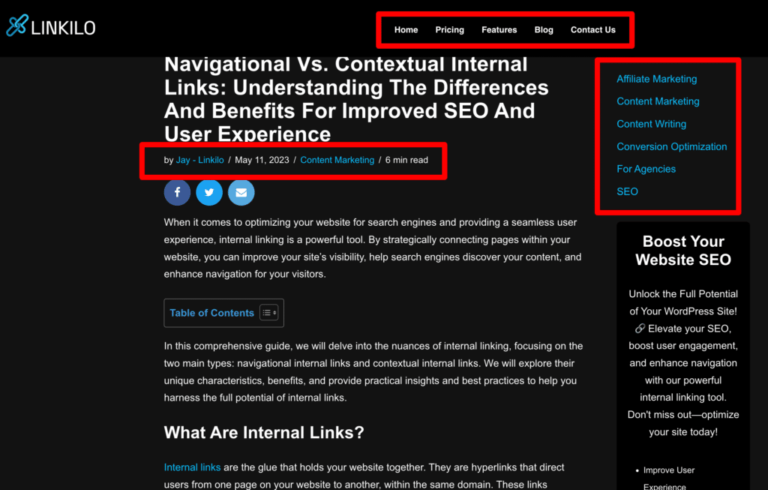Excessive internal linking can potentially harm SEO by diluting link value and confusing users. Over-optimization of internal links may lead to penalties by search engines.
Internal linking is a crucial aspect of SEO strategy, enhancing site navigation and spreading link equity throughout your website. When done correctly, it guides visitors to relevant content, increases the time they spend on your site, and improves the crawlability for search engines.
Yet, like any good practice, moderation is key. An abundance of internal links can be perceived by search engines as manipulative, possibly triggering a red flag that could negatively impact a website’s ranking. The balance of quantity and quality in internal linking practices ensures that your website remains user-friendly while reaping the SEO benefits. Crafting a structured internal linking approach helps to establish a clear hierarchy and thematic relevancy, essential for both user experience and search engine algorithms.

Credit: www.seobook.com
The Perils Of Excessive Internal Linking
Excessive internal linking can confuse readers and search engines alike. Noticeable signs that you’re overlinking include:
- A high volume of links on a single page.
- Links that don’t add value or context.
- Non-relevant links disrupting the content flow.
Too many links may lead to a poor user experience. Users can get overwhelmed and find it hard to locate useful information. This practice might also dilute link value and hinder the visibility of important pages. Aim for a balance to maintain a smooth navigation experience and enhance your SEO efforts.
Seo Penalties And Overlinking
Too many internal links can trigger SEO penalties. Search engines, like Google, see this as link spam. They prefer natural linking patterns that help the user.
Quality over quantity matters in SEO. A few well-placed links offer much more value than many meaningless ones. Users, and thus search engines, value a clear, helpful layout. Sites should have a user-friendly structure.
Search engines aim to provide the best results. They may view too many links as trying to game the system. This can lower your site’s ranking or even lead to a manual penalty.
| Quality Links | Excessive Links |
|---|---|
| Improve user experience | May seem spammy |
| Boost site relevance | Can hurt SEO |
| Help with site navigation | Lead to penalties |
Assessing Your Internal Link Structure
Analyzing your website’s internal links is vital for SEO health. A variety of SEO tools can help pinpoint the strength and weaknesses in your linking strategy.
- Google Search Console offers insights on site’s link profile.
- Many marketers use Screaming Frog SEO Spider for detailed link analysis.
- Ahrefs’ Site Audit feature is great for advanced users.
Spotting red flags demands close attention to certain patterns:
| Red Flag | Details |
|---|---|
| Broken Links | Links that lead nowhere, harming user experience and SEO. |
| Over-optimized Anchor Text | Using too many exact-match phrases can appear spammy. |
| Irrelevant Links | Non-related links may confuse both users and search engines. |
| Too Many Links | Pages with excessive links can dilute link value and focus. |
Best Practices For Internal Linking
Internal linking is a key SEO strategy. It guides visitors and search engine crawlers. Proper use ensures a cohesive website structure. For anchor text, always aim for natural, varied, and relevant choices. Diverse anchor texts prevent search engines from viewing links as manipulative. Relevant anchor texts reinforce content themes and improve user experience.
No-follow tags can be strategic. Use them on links that do not require indexing. This includes untrusted content or links with potential for user-generated spam. Remember, too many internal links could dilute link value. Also, remember to not go overboard with internal linking. Always prioritize user navigation and a natural flow of content.
Recovering From Overlinking Mistakes
Recovering from overlinking requires careful evaluation of your website’s internal links. Identify and remove unnecessary ones, ensuring those left aid user navigation and relevance. Aim for a balance, focusing on quality over quantity. Assess each link’s value from a user perspective.
Use tools to track changes in your site’s SEO performance post-cleanup. Look for improvements in page authority and user engagement. Such metrics reveal the impact of your cleanup efforts. Remember, a simplified, clear link structure often leads to a better user experience and can enhance SEO.

Credit: www.quattr.com

Credit: www.libertymarketing.co.uk
Frequently Asked Questions Of Can I Hurt My Seo With Too Many Internal Links?
How Many Internal Links Per Page For Seo?
A specific number of internal links per page is not set in stone, but typically 2-5 high-quality and relevant internal links are advisable for SEO to maintain user engagement and distribute page authority effectively.
Are Internal Links Good For Seo?
Yes, internal links are beneficial for SEO. They help distribute page authority throughout your website and improve user navigation, potentially boosting your site’s overall search engine ranking.
What Is The Limit Of Internal Links?
There’s no strict limit for internal links on a page, but keep them relevant and use them to improve user experience and site navigation. Too many can overwhelm readers and dilute link value. Aim for usability and quality over quantity.
Why Are Broken Internal Links Bad For Seo?
Broken internal links harm SEO by causing poor user experience and hindering search engines from properly indexing web content, which can lower rankings.
Conclusion
Striking the right balance with internal links is key. Overloading pages can dilute SEO efforts and confuse readers. Focus on providing value and clear navigation. Remember, thoughtful placement improves user experience and boosts rankings. Prioritize quality and relevance for the best results.




